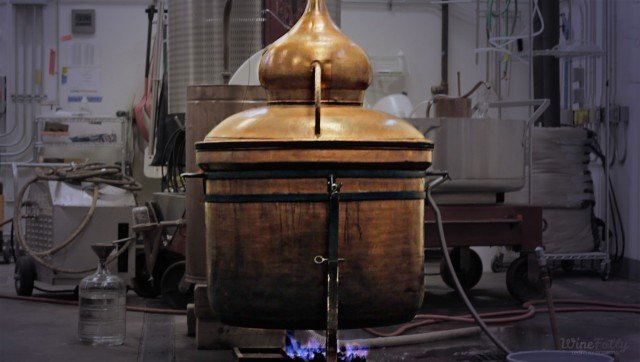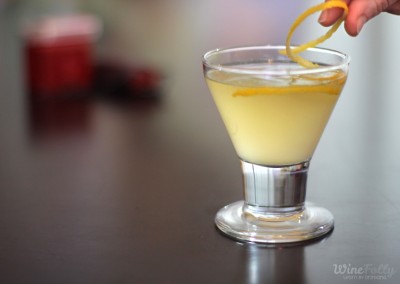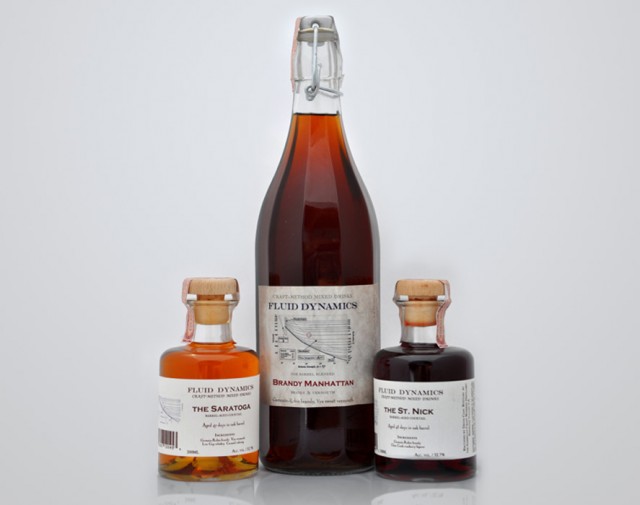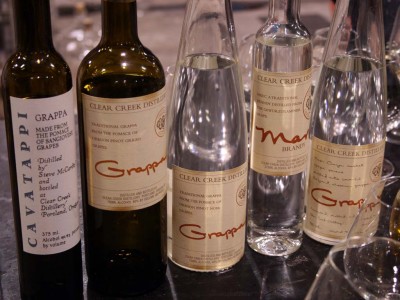There are many ways a winery can be ‘green’, however the idea of a zero-waste cellar hasn’t caught on…yet. In a zero-waste winery the excess waste that happens normally is distilled down to brandy, grappa or used in other wine-based products(such as vermouth). Distilled spirits, like brandy and vermouth, are growing in popularity in the cocktail community and there’s a demand for unique products. Here are a few wineries that are using the zero-waste winery ideology and making amazing new wine-based drinks.

Zero-Waste Winery in Action
BYOB Winery, Seattle, WA
Imagine standing in an industrial building that is about 10,000 square feet. There’s a huge block of racked oak barrels and a shiny stainless steel bottling line. While staring at all this familiar winery equipment and counting expensive French barrels full of wine, you see two copper stills with large open gas burners in full flame. This was the scene we walked into when visiting BYOB Winery, a custom crush facility in downtown Seattle. BYOB takes its surplus wine and distills it into brandy. From this point the winery can either use the brandy as a neutral grape spirit to add to dessert wines (such as Port), vermouth or make a proper oak-aged brandy.

While poking around BYOB we even came across the original location of Scrappy’s Bitters, who’s first blending lab was next to a large rack of various distilled liquors (such as Dolcetto and Nebbiolo ) and a shelf full of exotic spices, bitter roots and herbs.

The popularity of cocktails has exploded. The cocktail market is rich with a variety of bourbon, whisky, gin and vodka, however there are actually a limited number of American made wine-based cocktail components such as brandy, vermouth and wine-based aperitifs (such as Lillet). The increasing desire could easily be filled by wineries like BYOB who have a great opportunity to capture new audiences.
Making Exceptional Vermouth from Surplus Grapes
Cana’s Feast, Carlton, OR
After falling head over heels in love with a rare Italian vermouth called Chinato, winemaker Patrick Taylor realized he had all the tools in front of him to give-a-go at this unique style of vermouth. Traditional Chinato Barolo is nebbiolo grapes (the same grapes that go into Italy’s most coveted Barolo), quinine and a blend of heart-warming botanicals including clove, vanilla, star anise, fennel and cardamom. Taylor had access to nebbiolo grapes and was already making a varietal wine for Cana’s Feast, so after an arduous year of experimenting with roots, spices and herbs he created Cana’s Feast’s own Chinato d’Erbetti.

Cana’s Feast released it’s first Chinato d’Erbetti in February 2011 and Patrick Taylor had trouble selling it to winery visitors. Most wine lovers think the idea of additives in wine is heresy. However, on visits to craft cocktail bars in Portland and Seattle, Taylor was delighted to find how quickly bartenders and cocktail enthusiasts adapted it into classic drink recipes. The Chinato d’Erbetti is so popular they use their high-quality nebbiolo wine as a base. “We never expected this kind of enthusiasm!” mused Patrick Taylor, who plans to be prepared to meet future demand.
Cognac…ahem.. Brandy Made With Mendocino Wine Grapes
Germain-Robin, Mendocino, CA
If you’re not in Cognac, France you cannot call a brandy Cognac, however that doesn’t mean it’s any less amazing. Germain-Robin started with a partnership of two people in 1982 with a passion for craft-method distillation, techniques handed down for centuries from master to apprentice.* (*Germain-Robin site). By using premium wines and grapes that were often bought at surplus prices, Ansley Coale and Hubert Germain-Robin started producing very unique brandies made with Pinot Noir, Chenin Blanc, Sauvignon Blanc and others.

This sort of diversity in a winemaking region introduces new amazing products to wine drinkers and cocktail drinkers alike. It opens up stuck markets and provides inspiration for people to try new things and be creative (drinking-wise & producing-wise). A terrific example of a new product line developed as a wine-based cocktail drink is Fluid Dynamics Brandy Manhattan.
Grappa, a High-End Liquor Made with Winery ‘Waste’
Clear Creek Distillery, Portland, OR

The wineries donate or sell their grape pomice, a winemaking by-product, to Clear Creek who distills it into grappa (wikipedia definition). With a product line of grappas including pinot noir, nebbiolo, sangiovese and even gewurtztraminer, Clear Creek has slowly but surely reinvigorated cocktail enthusiasts to the ancient craft of grappa production. As the demand for grappa increases, wineries can recycle what would be a by-product into high quality liquors.
It’s Legal
All of this can be done legally in a Bonded Winery in two ways.
- An additional Distilled Spirits Bond with a Wine Premise Alteration
- Or Just a Wine Premise Alteration (just for handling spirits–not making them)
If you run a winery or know someone who does, check out this direct link to the legal documentation to Wine Premise Alteration at https://gpo.gov
